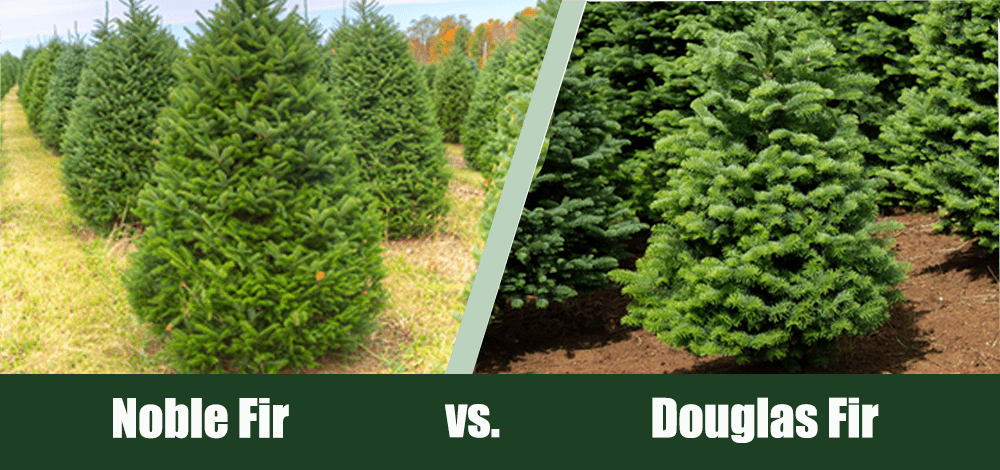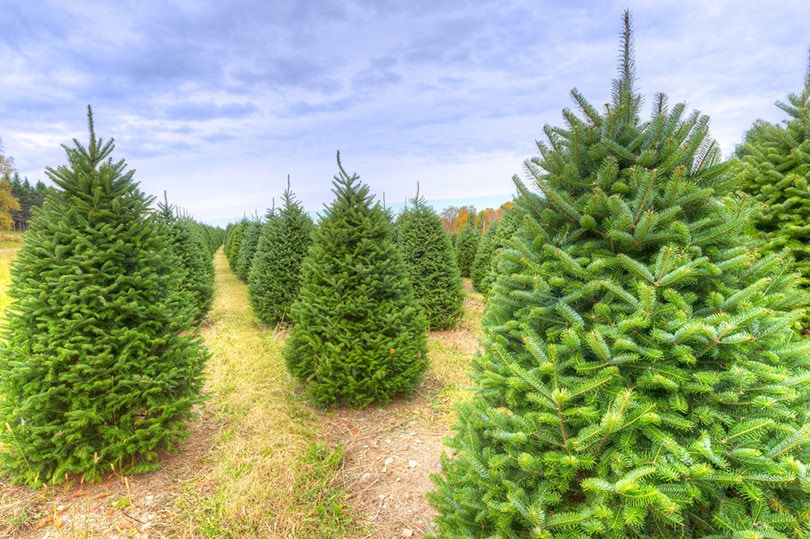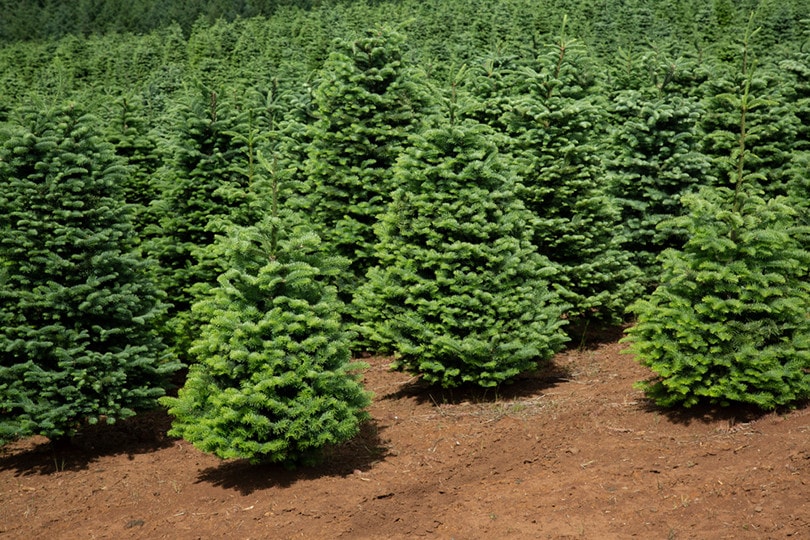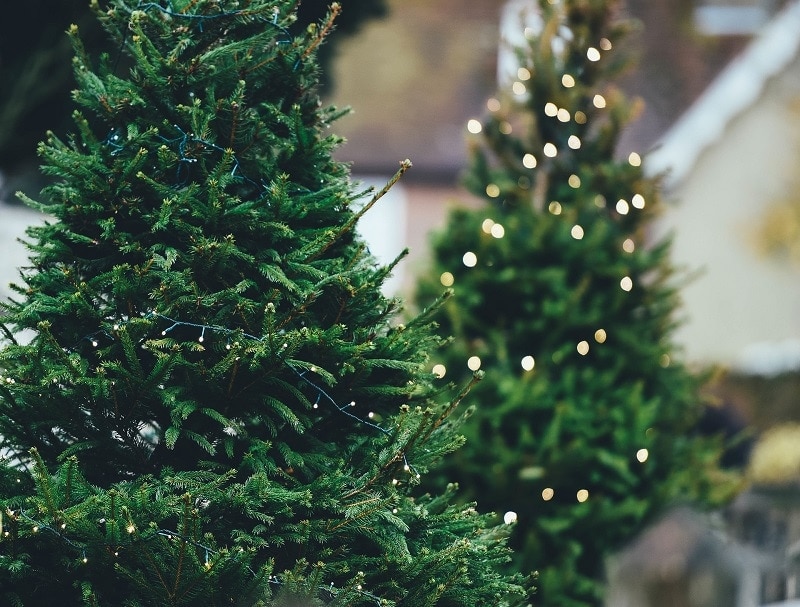Noble Fir vs. Douglas Fir Trees — What’s the Difference?
-
Pete Ortiz
- Last updated:

Noble Fir and Douglas Fir trees are both popularly used as Christmas trees. However, while the Noble Fir is a true fir tree, the Douglas Fir is actually a member of the coniferous pine tree family and is not a true fir at all.
While the Douglas Fir is preferred for its uniform shape, the Noble Fir boasts the best needle retention but is one of the most expensive festive tree options. Read on for more information about these trees, including how and where they grow, as well as their prowess as Christmas trees for the home.
Overview of Noble Firs:

The Noble Fir is also referred to as the Red Fir. It is native to the Pacific Coast of the United States and grows at altitudes up to 1,500 meters. It is considered the world’s tallest true fir tree. It has been introduced to countries across the world, including Britain and Denmark.
Habitat
The Noble Fir is primarily found in Washington and Oregon as well as the northwest region of California.
Appearance
This is a large evergreen tree and can reach heights of 230 feet tall. Its bark is gray when the tree is young and turns reddish-brown as it ages. It has needle-like leaves between ½ and 1½ inches thick that are blue-green in color.
Uses
The Noble Fir has enjoyed a number of uses over the centuries. It was used to treat coughs and colds by the Paiute, and early loggers called it “larch” and favored it for its combination of light weight and strong nature. It has been used in paper manufacturing, general construction, and even in the manufacturing of Mosquito Bombers during World War II. Today, it is more commonly used as a Christmas tree and is especially popular in Britain and Denmark for this purpose.
- Very good needle retention
- Sturdy branches that will hold decorations and ornaments
- Attractive bluish-green foliage
- Fir smell makes it popular as an indoor Christmas tree
- Retains its shape and appearance for several weeks
- Expensive
- Difficult to get hold of

Overview of Douglas Firs:

Like the Noble Fir, the Douglas Fir was discovered by David Douglas, from whom this coniferous tree gets its name. The Douglas Fir is not a true fir but is part of the pine family of trees. As well as being used as a Christmas tree in countries around the world, it is also a popular wood used for construction and in the manufacture of items like furniture, flooring, and decking. As a Christmas tree, it is less expensive than the Noble Fir and has a good shape but does not retain needles as well.
Habitat
Also known as the Douglas Spruce, Oregon Pine, and Columbian Pine, the Douglas Fir is found from British Columbia to California. It is found at elevations up to 1,500 meters and is also found on the coast at sea level. It is now found throughout Europe and in Argentina and Chile, while in New Zealand, the Wilding Conifer, as it is known, is considered an invasive species.
Appearance
The Douglas Fir can grow to heights in excess of 300 feet and may live more than 500 years. There are examples of this species living 1,300 years or more. The needles grow to between ¾ and 1 ½ inches and they have gray bark when the tree is young, but it becomes more of a dark brown as the tree ages. The Douglas Fir is known to be one of the most fire-resistant conifers in the US.
Uses
The Douglas Fir enjoys extensive uses in various ways. It is a very popular building material and has been used in timber frame construction for hundreds of years because of the wood’s strength and durability, as well as its ability to resist rot and weather. It has been used as firewood because it does not give off harmful toxins when burned, and its tight grain and attractive, light color means that it is used in the crafting of furniture and other decorative items.
- Dimensional stability makes it a good construction material
- Attractive grain is beneficial for ornamental work
- Its conical shape is considered attractive as a Christmas tree
- Cheaper than a lot of other Christmas tree options
- Needles can fall off easily
- Expensive as a construction material
Which Is the Best Christmas Tree?
Generally, the Noble Fir is considered the better Christmas tree option because it has soft needles, strong branches that can hold ornaments or virtually any weight, and it has a very long needle retention period, so buyers won’t have to sweep up every morning. However, it is not as widely available as the Douglas Fir, and when it is available, it has a higher cost. Some Noble Firs have to travel long distances before they are put up in the house, which means that a lot of the pine retention benefits have been lost by the time the tree is put up.
The Douglas Fir is more readily available and costs less than the Noble Fir. It has soft needles, and its blue-green color is quite unique. The tree is dense, too, and it has a distinctive smell that many people love. Although not as good as a fresh Noble Fir, the Douglas Fir still has very good needle retention and may not have to travel as far before being erected.
Where available and not too costly, the Noble Fir is likely the best choice of Christmas tree, although some will still prefer the Douglas Fir, and its availability makes it the preferred choice in most instances.

Building and Construction Material
Availability is a concern for the Noble Fir for use as a construction material, too. It is harder to find this timber than it is Douglas Fir, and it has a high price tag because of that. And, because it is a true fir, its sap can be an irritant to the skin in some cases. However, it is an attractive wood, is strong, and is resistant to most pets.
Douglas Fir is one of the most sought-after building materials because it is strong, but it is also easy to work with. It accepts nails and other fastenings easily and can be painted, although this will hide the attractive grain of the wood itself.
Douglas Fir is generally preferred as a construction material. It is pricey but it is easy to work with manually and easy to machine. It is also more readily available than Noble Fir.
- Related Read: Spruce vs. Fir vs. Pine Trees – What’s the Difference?
 Conclusion
Conclusion
The Noble Fir is a true fir, so named to differentiate actual fir trees from the Douglas Fir, which is not really a fir tree at all. Both are native to the US, and both are used as construction material and commonly bought as Christmas trees. However, the greater availability of the Douglas Fir means that it is the most commonly preferred choice of the two, whether as a Christmas tree or for use in construction and DIY projects.
- https://en.wikipedia.org/wiki/Abies_procera
- https://www.auntleahs.org/wp-content/uploads/2020/10/How-to-choose-a-fresh-tree-Oct-14.pdf
- https://forestryandland.gov.scot/learn/trees/noble-fir
- https://en.wikipedia.org/wiki/Douglas_fir
- https://www.fpl.fs.fed.us/documnts/usda/amwood/noblefir.pdf
- https://www.woodworkingnetwork.com/wood/wood-month/fir-comes-many-species-lumber-looks-same
- https://vanspinesnursery.com/exotic-conifers-the-noble-fir/
Contents

